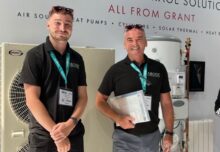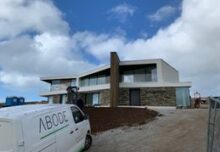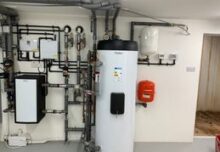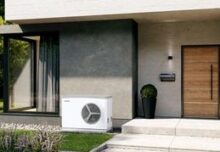As the UK works to achieve its net zero carbon emissions goal by 2050, addressing the carbon footprint of our heating systems needs to be a priority, especially as almost a third of all the UK carbon emissions are from the heating for our homes and workspaces1.
In working towards this goal of net zero, virtually all heat in buildings will need to be decarbonised2. The government has planned to potentially ban gas boilers from all new builds from 2025, and oil boilers from 2026, with the ambition that from 2035 all new heating appliances installed in properties are low-carbon technologies like heat pumps.
In 2025 the Future Homes Standard will be introduced ensuring that newly built homes are fitted with low-carbon heating and high levels of energy efficiency, but one challenge the UK faces is the decarbonisation of our “hard-to-treat” homes.

The challenge of “Hard to Treat” properties.
An estimated 10 million properties in England are hard-to-treat3, referring to properties with characteristics or construction features that present challenges when improving the energy efficiency of the property, or retrofitting modern technologies.
Nearly 84% of hard-to-treat properties are private sector properties4, which would benefit from energy efficiency improvements and modern heating systems, especially considering the current energy crisis and cost of living concerns.
Older homes are more frequently challenging to decarbonise, and their residents are more likely to be in fuel poverty, with properties with uninsulated solid walls having the highest rate of fuel poverty. Here are two of the main characteristics of hard-to-treat homes in the UK:
Solid Wall Construction: Many older UK homes have solid walls, offering poorer insulation when compared to modern cavity walls. Insulating solid walls requires specialised techniques such as internal or external insulation systems, making it a complex, costly, and often impractical measure.
Listed Buildings: Historic or listed buildings are subject to strict regulations and restrictions. Preserving the historical integrity of a listed building, whilst improving their energy efficiency requires careful consideration.
How Can Heat Pumps Help?
There seems to be a common misconception that these older hard-to-treat properties are considered to be hard to heat, and unsuitable for low-carbon technologies like heat pumps. However, with careful consideration and accurate system design, heat pumps can provide a viable alternative heating solution for any property.
There are two main types of heat pumps, neither relying on fossil fuels, meaning that they’re much better for the environment than oil, LPG, or gas boilers. Air source heat pumps take energy from outside air, using it to provide space heating and hot water, whilst ground source pumps absorb thermal heat energy from the ground.



Has it Been Done Before?
Yes, it has! Abode Heat regularly gets asked to look at designing and specifying heat pump systems for hard-to-treat properties. Abode Heat has installed heat pumps into some of the South West’s older more, unique properties.
Here you will see two traditional Cornish properties. One (below left) is near Callington and is a solid walled farmhouse, recently renovated with an air source heat pump and new underfloor heating system, whilst the other (below right) is a large 476m solid walled manor house on the Bodmin moors, heated by a cascade ground source heat pump system with radiators.


Here are some examples of heat pump installations in hard-to-treat properties Abode Heat has completed in other parts of the South West.
The first property (below left) is an old solid walled mill building near Barnstaple, now heated by a cascade air source heat pump and radiators.
he second (below right) is another property in Devon, an old solid walled cottage in South Hams, where another air source heat pump replaced the existing aging oil boiler.


Here are another two properties where new heat pump installations are proving to be modern, reliable heating systems. Firstly a property in Somerset (below left) , where the air source heat pump compliments and works alongside the existing boiler and heating distribution as a hybrid system.
Next we have a property in Warwickshire (below right) that is a large, recently renovated barn with a total floor area of 377m . The barn makes up two separate dwellings, both heated by air source heat pumps with underfloor heating.


Here are another two Cornish properties that have recently had heat pump systems installed. The first (below) is right on the coast near to Lands’ End, where an air source heat pump has replaced an ageing direct electric heating system. You can find the full case study here for this Cornish Coastal Property, including the homeowners own thoughts on their new heat pump.


Finally, here is a renovated boat house (below) located on the Helford passage with a thatched roof. Abode replaced its existing direct electric heating with a new air source heat pump and radiator system. This property is used as a high-end holiday home and the heat pump provides an efficient heating system that the owners can rely on to keep their guests warm.

This installation has recently been filmed by Vaillant (the manufacturer of the heat pump) for a series of case studies featuring Kevin McCloud, presenter of Grand Designs. These videos answer common questions about the practicalities of installing and living with heat pumps, as well as dispelling myths about properties that might not be thought suitable for these low-carbon systems.


Here you can find the video case study, which includes Kevin McCloud interviewing both the homeowners and the Abode Heat.
Homeowners of these hard-to-treat properties often tell us how surprised at how warm the heat pumps are keeping the property. Another regular comment customers with air source heat pumps make, is how they can’t believe just how quiet the heat pump is. This shows that with careful consideration into the design of the heat pump system, heat pumps can work effectively in hard-to-treat and hard-to-heat properties.
Where to Start When Looking at Heat Pumps?
Room-by-Room Heat Loss Calculation

An accurate room-by-room heat loss calculation is always the first step in designing an effective heat pump system. This calculation considers the dimensions of each room, the construction materials that the room is built out of, and its position in the property. This builds a picture of how the property leaks heat, allowing the designer to calculate the peak heating requirement of the property. This allows the accurate specification of a heat pump system able to meet 100% of the property’s space heating and hot water needs, throughout the whole year.
In older properties with low levels of insulation, it is critical to understand how much heat the property will need to ensure a heat pump with sufficient heating output is specified. Whilst designing heat pump systems for properties considered hard to heat, we take into account those unfavourable characteristics, for example, solid walls or poor insulation.
The heat loss calculation will most likely find that this type of property will have a higher peak heating requirement when compared to a well-insulated modern property, requiring either a heat pump with a larger capacity or multiple heat pumps working together.
You can find more information on the importance of heat loss calculations when installing a heat pump system here.
Energy Efficiency Improvements

When considering a heat pump system, it is always worth looking at what improvements can be made to the energy efficiency of the property. With hard-to-treat properties, it might be the case that not a lot of improvements are possible or practical. If there are improvements to be made, they will lower the long-term running costs of the heat pump system as well as potentially reducing the size of the heat pump required. By using heat loss calculations, we can estimate the running costs of the system, both with and without any new energy efficiency measures, giving you all the information you need to make an informed decision on planned works.
What About the Heating Distribution?
Room-by-room heat loss calculations also give the designer the output required from each room’s heating distribution (radiators or underfloor heating) necessary to heat the room to the designed temperature.
Existing Systems
Approximately 74% of hard-to-treat properties have an existing heating system with radiators5, most likely to be working with a traditional combustion-based boiler running at a flow temperature between 60°c and 70°c. The flow temperature of a system is the temperature at which the boiler heats the water before sending it out to the radiators.
Low Flow Temperature Distribution
Heat pumps are at their most efficient running at the lowest flow temperature possible, which is why underfloor heating compliments heat pumps well, as typically underfloor heating runs at a flow temperature between 35°c to 45°c. Retrofitting underfloor heating into older hard-to-treat properties is often costly and impractical.
It is possible to design a radiator distribution system to work with a heat pump, but instead of a 60°c to 70°c flow temperature found in traditional systems, a radiator system designed for a heat pump system will run at a 55°c or lower flow temperature.
This lower system flow temperature is achieved by upgrading the existing distribution to larger modern radiators, taking care to ensure the outputs of the new radiators meet each room’s required output as laid out in the room-by-room heat loss design.

Existing Pipework
Usually, the existing heating distribution pipework in a property can be reused, avoiding the disruption of changing large runs of pipework. Standard radiator pipework is 15mm, anything smaller is called microbore pipework and can hinder flow rates that can be achieved, which can affect the efficiencies of heat pump systems. Sometimes it is the case that the microbore pipework would need to be replaced and re-piped with standard 15mm pipework for the system to be suitable for a heat pump.
What Else Do I Need to Consider?
Just like retrofitting any heat pump system into an existing property, several factors need to be considered when looking at hard-to-treat properties, including:
Existing Electrical Supplies
New electrical supplies will need to be installed for the new heat pump system. This may include power supplies being run from the consumer unit to the external heat pump and internal equipment locations. Depending on the age of the existing consumer unit, that might need upgrading as well.
DNO Notification
As part of a heat pump installation, the District Network Operator (DNO) needs to be informed. A heat pump with smaller outputs is classed as “connect and notify” where you only need to inform the DNO after the heat pump installation has taken place. Hard-to-treat properties might need heat pumps with larger outputs, which are classed as “apply to connect”. This means permission from the DNO must be given before the installation, confirming they are happy with the additional load on the existing supply.
Planning
Most air source and ground source heat pump installations are considered to be ‘permitted developments’ which means that you don’t need planning permission.
There are exceptions to this, so it’s best to double-check with the local planning authority, especially if the property is a listed building or in a conservation area.
Noise
MCS 020 is the planning standard for air source heat pumps. To comply with this standard and be considered ‘permitted development’, the location of the air source heat pump should have a sound level lower than 42 decibels when measured at the nearest habitable room in the neighbouring property.
Available Space
Ground source heat pumps work by extracting thermal energy (heat) from the ground through an external collector system made up of either loops of horizontal pipes or boreholes. If the land you have available is a garden as opposed to a field, then it’s likely that you don’t have enough room for an efficient horizontal ground loop system. You could look at a vertical borehole system, allowing you to use a ground source heat pump without the large amount of space required for a horizontal system. An air source heat pump should be at least 1 meter from a neighbouring boundary and positioned to allow optimal airflow around the system.
You can find more about what considerations are involved when installing heat pumps into existing buildings on the Abode Heat website.
Summary
To summarise, when designed properly air source and ground source heat pumps can provide an effective alternative heating system for hard-to-treat homes. Abode Heat has over 15 years of experience in exclusively designing and specifying heat pump systems and believes heat pumps can play a pivotal role in the modernisation and decarbonisation of the South West’s heating systems.

Next Steps
To explore heat pump solutions for “hard to treat” properties and take a step towards decarbonization, contact Abode Heat on 0333 577 9292. The Abode Heat team will be able to go through your project in detail and advise on the most suitable heat pump system for the property.
Abode Heat also run Heat Pump Go, our own MCS umbrella Scheme. If you are a plumber or heating engineer interested in starting your journey into renewables, or needing assistance with ensuring your heat pump systems are designed and sized properly, get in touch and find out how Abode Heat can help you.
You can find out more details about our MCS Umbrella Scheme here.
References
- Department of Business, Energy & Industry Strategy (2021) Net Zero Strategy: Build Back Greener, p 22. Available at: https://assets.publishing.service.gov.uk/government/uploads/system/uploads/attachment_data/file/1033990/net-zero-strategy-beis.pdf (Accessed 13 July 2023)
- HM Government (2021), Heat and Buildings Strategy, p 11. Available at: https://assets.publishing.service.gov.uk/government/uploads/system/uploads/attachment_data/file/1044598/6.7408_BEIS_Clean_Heat_Heat___Buildings_Strategy_Stage_2_v5_WEB.pdf (Accessed 13 July 2023)
- DG Cities (2023),Hard to Treat Homes, Available at: www.dgcities.com/hard-to-treat-homes. Accessed 13 July 2023.
- BRE Group (2028), A study of Hard to Treat Homes using the English House Condition Survey, p 5. Available at: https://files.bregroup.com/bre-co-uk-file-library-copy/filelibrary/pdf/rpts/Hard_to_Treat_Homes_Part_I.pdf (Accessed 13 July 2023)
- BRE Group (2028), A study of Hard to Treat Homes using the English House Condition Survey, p 14. Available at: https://files.bregroup.com/bre-co-uk-file-library-copy/filelibrary/pdf/rpts/Hard_to_Treat_Homes_Part_I.pdf (Accessed 13 July 2023)






